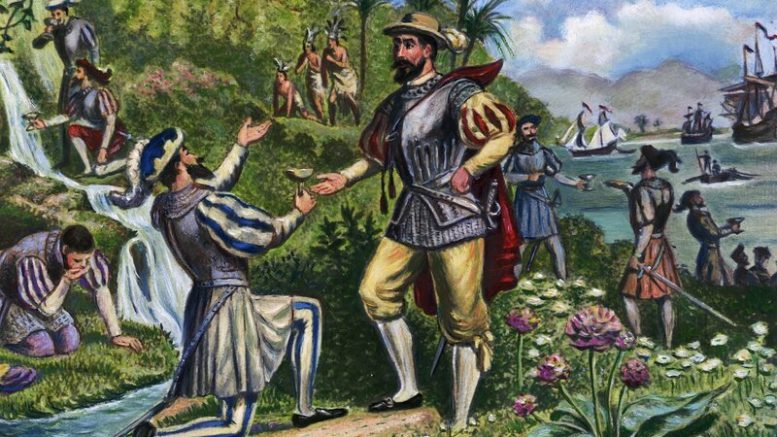Ep.2: Ponce de Leon & The Fountain of Youth
Podcast by Mattison Hansen
[BED MUSIC]
Mattison: Welcome back to “Legends Revealed,” a podcast where I look in to the truth behind local legends that stem from the nation’s oldest city – St. Augustine.
[END OF BED MUSIC]
Is eternal youth possible? Humankind have asked this question for over 1,000 years. We’ve tried continuous cures to stop getting older – whether it be fad diets, expensive medical treatments, or even supposedly “magic” supplements. But one of the most persistent legends, especially in Florida, is the possibility of the Fountain of Youth located in St. Augustine.
What’s the truth behind this story? Well, let’s take a look.
Stories of magical healing waters that can preserve youth and heal illness have been told throughout recorded history, and probably even before that. Nearly every culture in history has created folk tales involving a magical body of water. For instance, Alexander the Great made mention of a medicinal “river of paradise” in his travelogues, a few mythical middle-aged European kings were said to reign for centuries based on regular submersions in enchanted lakes, and many more developed in considerably diverse locations as the Canary Islands, Japan, Polynesia and England.
Despite all of the stories, there is no historical figure more mutually linked with the legend of the Fountain of Youth than Ponce de Leon. The legend of the mysterious spot told by the Taino Indians of the Caribbean reached the ears of the Spanish explorer in the late 1400s, piquing his interest enough that he staged multiple expeditions to search for the fountain into early Spanish colonial areas such as Bimini, Puerto Rico, and the Florida coast in the early 1500s. Some thought Ponce de Leon became obsessed with his search for the magical waters, but numerous scholars claim that Ponce de Leon was actually in search for more land, but might have been told to keep an eye out for the fountain – which experts also dispute.
Whether it was his obsession to find the fountain of youth or his attraction for land and riches, Ponce de Leon and his crusade eventually came to an end when he was mortally wounded in a battle with tribal warriors in 1521.
The truth behind Ponce de Leon’s association with the Fountain of Youth stems from about 10 years after his death by Gonzalo Fernandez de Oviedo y Valdes. In 1535, the great Spanish chronicler published the first 15 of 50 ‘books’ of his classic Historia general y natural de las Indias. In it, Oviedo praised the actions of the men he admired, as well as vilified the greed and stupidity of others. One of his targets: Juan Ponce de Leon. For Oviedo, Ponce de Leon was a vain and gullible man, susceptible to pursue silly ventures that enhanced his own ego, no matter the cost.
Another Spanish chronicler, Antonio de Herrera y Tordesillas, reinforced Oviedo’s claims. Herrera’s 1601 chronicle, which is too long for me to even attempt to pronounce, provides the most detailed account of Ponce’s voyage and appears to have been based, in part, on original accounts of the expedition. Since Herrera’s chronicle was published, the historical association between Ponce’s 1513 expedition and the Fountain of Youth has been repeated.
Though the claims suggest Ponce met his end before he could complete his search, Ponce de Leon’s failure to locate the fountain only fueled its elusive legend, and made other explorers more determined to hunt it down. Over the centuries, many adventurous explorers have attempted to find the fountain, but instead became part of the doomed-to-fail searches for the legendary site.
Nowadays, as society, science and human knowledge became more advanced, the idea of there being such a thing as a “Fountain of Youth” began to seem less and less likely. The stories eventually began to be passed down as myths rather than history.
By the time the Spanish ceded control of Florida to the young United States in 1819, the stories of the Fountain of Youth had all but sank into the early history. That is, until a renewed interest in literary myths fueled by popular folk heroes sparked a hunger for tales of early American legends.
The folk tales of early America are still told today, and the Fountain of Youth is one of the most often stories told in Florida.
Now, if you’re asking me if the Fountain of Youth was really out there, I believe we’ll never know for sure. One thing we do know, however, is that the mystery of the “healing waters” is a big part of the structure of St. Augustine’s long past.
[BED MUSIC]
This was the second episode of “Legends Revealed.” Until next time, my name is Mattison Hansen.
[END OF BED MUSIC]



Be the first to comment on "Legends Revealed: Ponce de Leon & The Fountain of Youth"